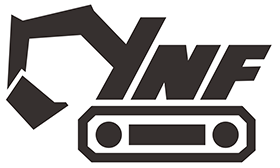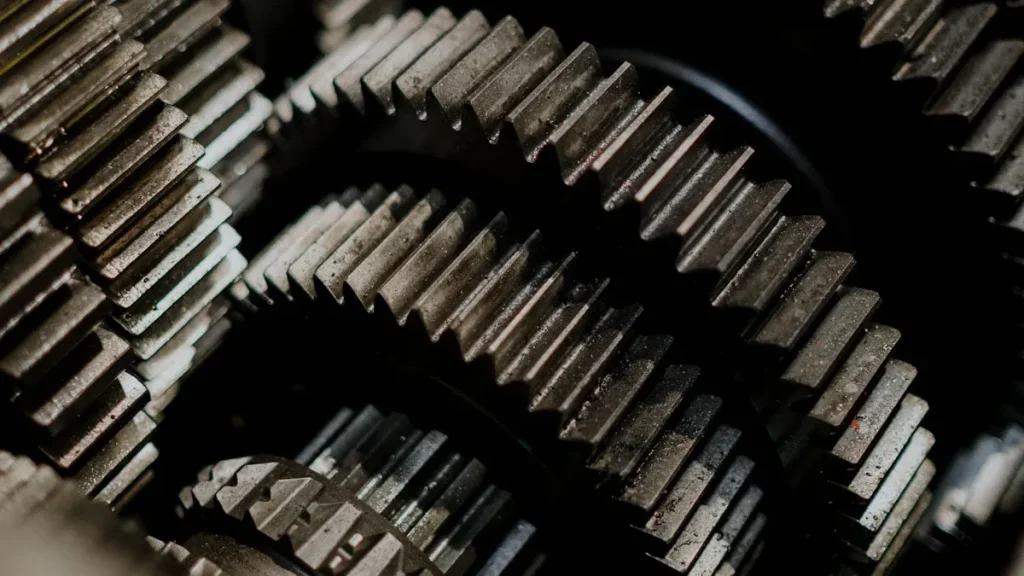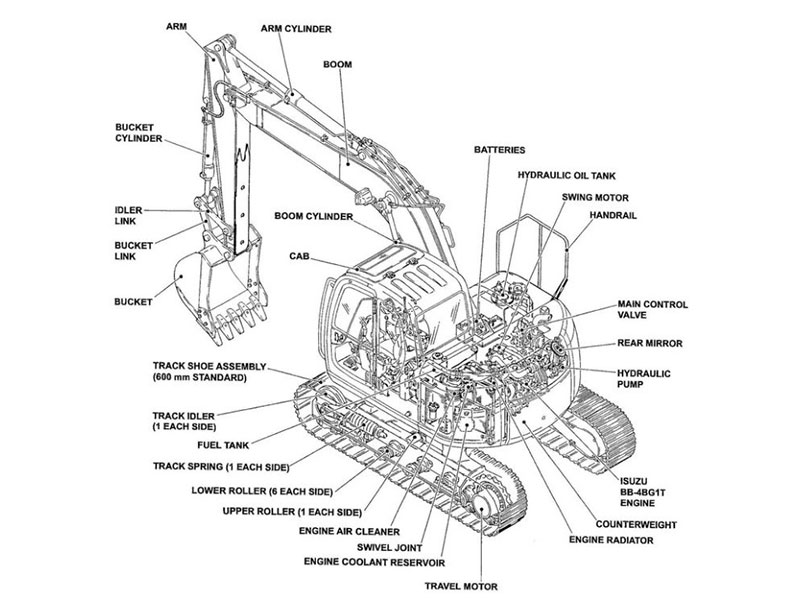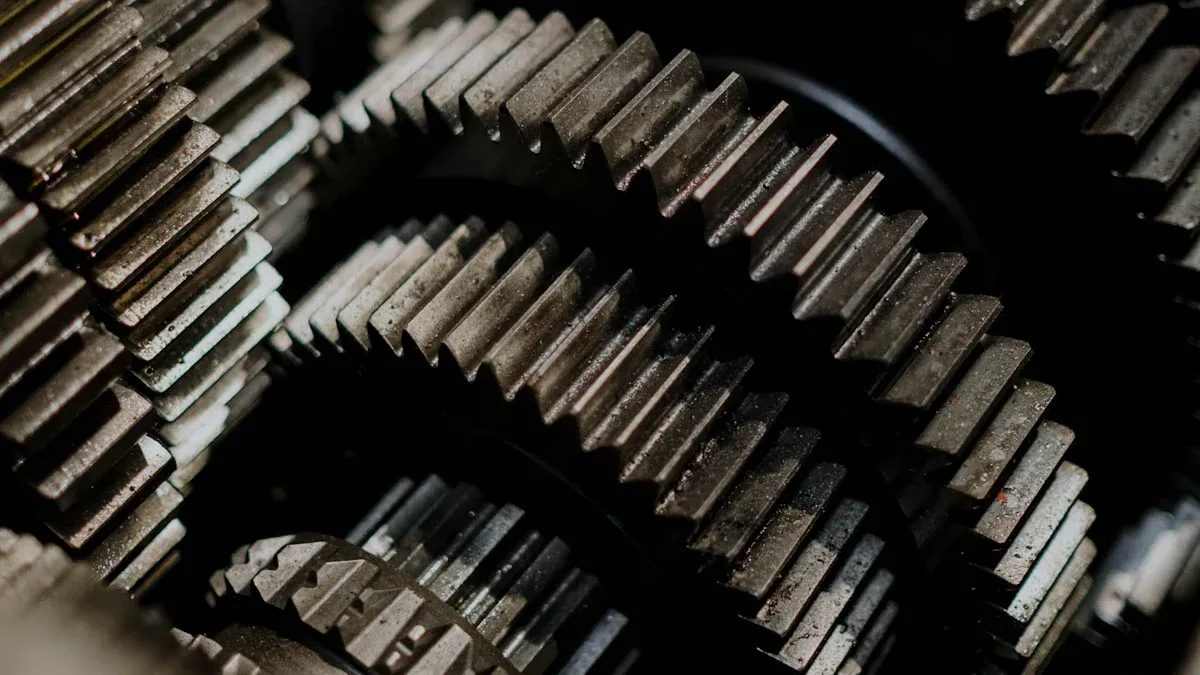
Excavator transmission parts include the hydraulic motor, excavator final drive parts, clutches, drive shafts, torque converters, bearings, seals, and undercarriage components. These major parts of an excavator work together to transfer power efficiently from the engine to the tracks. Each part supports movement, control, and durability. Accurate speed measurement and low transmission error rates—less than 5% under normal load—help maintain strong excavator performance. The main components ensure reliable operation, making regular maintenance of all excavator parts essential for long-term power and final drive efficiency.
Parameter/Statistic | Value/Description |
|---|---|
Transmission error change rate | Less than 5% (normal load) |
Accurate speed measurement | Crucial for performance and reliability |
Key Takeaways
Excavator transmission parts like hydraulic motors, final drives, clutches, and drive shafts work together to move and control the machine efficiently.
Regular maintenance and inspection of transmission parts prevent breakdowns, extend machine life, and improve performance.
Using high-quality OEM parts and proper lubrication helps protect components and reduces repair costs.
Advanced control systems and sensors improve power delivery, accuracy, and safety during excavator operation.
Coordinated function of all transmission parts ensures smooth movement, strong power flow, and reliable performance on tough jobs.
Excavator Transmission Parts Overview
What Are Excavator Transmission Parts
Excavator transmission parts include all the components that transfer power from the engine to the tracks and working arms. These parts of an excavator work together to move, lift, and control the machine. The main excavator transmission parts are the hydraulic motor, final drive gears, clutches, drive shafts, torque converters, bearings, seals, and undercarriage. Each part has a specific job. For example, the hydraulic motor creates movement, while the final drive gears help control speed and direction. The drive shafts connect different parts and send power where it is needed. Bearings and seals protect moving parts and keep dirt out. The undercarriage supports the tracks and helps the excavator move over rough ground.
Modern excavator transmission parts are managed by Electronic Control Units (ECUs). ECUs adjust gear shifts, manage hydraulic fluid flow, and control engine timing. These smart systems help the excavator use less fuel and work more efficiently. ECUs also allow remote monitoring of machine health and location, making maintenance easier and more accurate.
Why Transmission Parts Matter
Transmission parts play a key role in the performance and reliability of every excavator. When all parts of an excavator work well together, the machine can move smoothly and handle heavy loads. If any part fails, the excavator may lose power or stop working. Studies show that accurate modeling of transmission parts, like the tracked walking system and final drive, helps engineers design machines that handle real-world loads and torque changes. This leads to better performance and longer life for the excavator.
Another study found that keeping the travel gearbox in good condition is vital for excavator performance. Using advanced fault detection methods, experts can spot problems early and prevent costly breakdowns. Regular maintenance of all excavator parts, especially the final drive and transmission, keeps the machine running safely and efficiently. Good maintenance also reduces downtime and repair costs, helping owners get the most from their investment.
Main Types of Excavator Transmission Parts
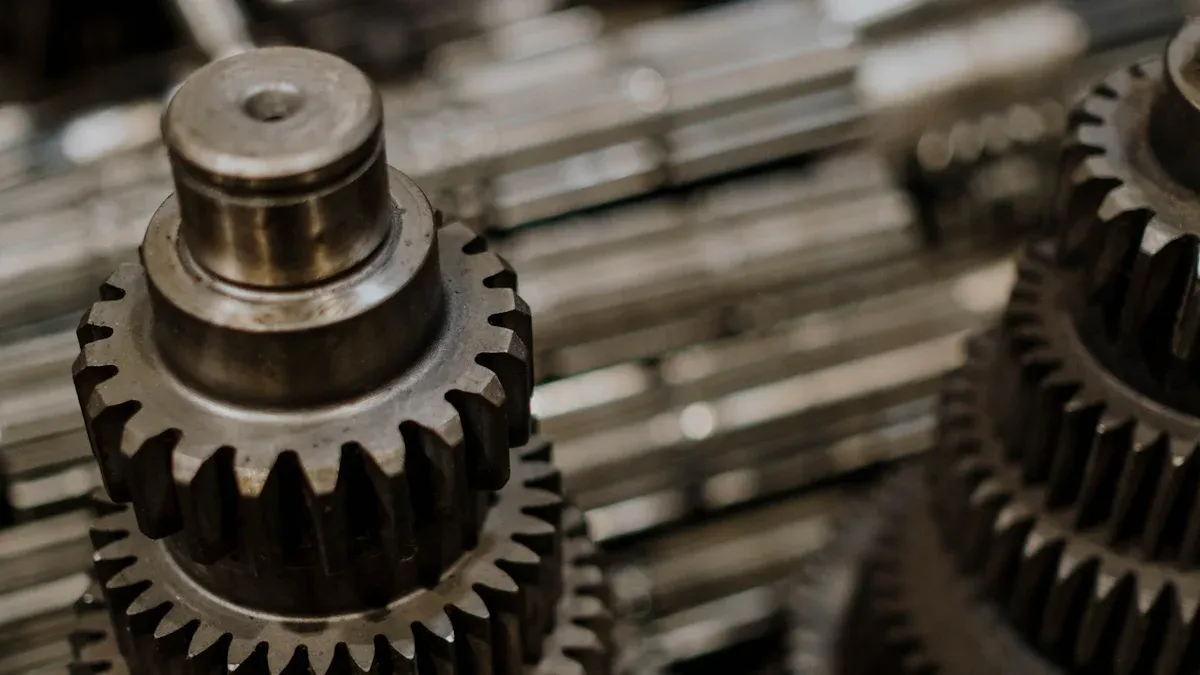
Hydraulic Motor
The hydraulic motor is one of the most important excavator parts. This motor changes hydraulic energy into mechanical energy. It sends power to the tracks and working arms. The hydraulic motor controls the speed and direction of movement. Different types of hydraulic motors exist, such as gear, vane, and piston motors. Each type offers unique benefits for various excavator types. The hydraulic motor works with other transmission parts to provide smooth and strong movement. When the hydraulic motor operates well, the excavator can lift heavy loads and move across rough ground. Proper alignment and tight tolerances in the hydraulic motor increase efficiency and reduce early failures. A case study by Tuff Torq Corporation showed that improving the alignment of transmission components, like the centercase, increased reliability by 17.6%. This proves that small changes in manufacturing can make a big difference in excavator performance.
Excavator Final Drive Parts
Excavator final drive parts include the gear reduction system, planetary gears, bearings, and seals. These parts work together to transfer power from the hydraulic motor to the tracks. The final drive reduces the speed from the motor and increases torque, which helps the excavator move heavy loads. The final drive components also control the direction of movement. Industry reports highlight the importance of using the correct oil and keeping hydraulic fluid at the right level. This reduces friction and prevents overheating. Regular inspections for leaks, cracks, and noise help find problems early. Proper lubrication and timely replacement of worn final drive parts keep the excavator running smoothly. Using high-quality OEM parts extends the life of the final drive and improves efficiency. The final drive is one of the most critical excavator parts for power and movement.
Clutches
Clutches are key transmission parts in many excavator types. The clutch connects and disconnects the engine from the transmission system. This allows the operator to control when power flows to the tracks or working arms. Clutches help the excavator start, stop, and change direction smoothly. There are different types of clutches, such as friction, hydraulic, and electromagnetic clutches. Each type offers specific benefits for different excavator types. A well-maintained clutch prevents jerky movements and reduces wear on other parts. Clutch problems can cause power loss or make the excavator hard to control. Regular checks and timely replacement of clutch parts keep the transmission system reliable.
Drive Shafts
Drive shafts connect the hydraulic motor to the final drive components. These shafts transfer torque and power between different parts of the excavator. The drive shaft must handle high loads and twisting forces. Studies show that fatigue fracture is the main reason for drive shaft failure. Cracks often start at the spline root and spread, causing the shaft to break. High stress at certain points increases the risk of failure. Research also shows that better materials and improved design can make drive shafts last longer. Regular inspection for cracks, wear, and corrosion helps prevent sudden breakdowns. Using strong materials and good design reduces stress and increases the service life of drive shafts. These parts play a vital role in the transmission system and overall excavator durability.
Torque Converters
Torque converters are special transmission parts that help control power flow in the excavator. The torque converter sits between the engine and the transmission. It uses fluid to transfer power and multiply torque when needed. This allows the excavator to start moving smoothly and handle changes in load. The torque converter also protects the engine and transmission from sudden shocks. There are different types of torque converters, such as single-stage and multi-stage designs. Each type offers unique benefits for different excavator types. A well-functioning torque converter improves fuel efficiency and reduces wear on other parts. Regular checks for leaks and fluid quality help keep the torque converter in good shape.
Bearings and Seals
Bearings and seals are small but essential excavator parts. Bearings support rotating shafts and reduce friction between moving parts. Seals keep dirt and water out of the transmission system. New types of bearings, such as hybrid designs with ceramics and advanced steel, offer higher load capacity and better heat resistance. These innovations increase the lifespan of bearings and reduce maintenance costs. Rolling bearing components, like cages and lubrication systems, help keep the excavator running smoothly. Proactive maintenance can cut equipment failures by up to 50%. Proper lubrication lowers failure rates by up to 30%. Using high-quality replacement parts and keeping the lubrication system clean extends the life of bearings and seals. These parts protect the transmission and final drive from damage.
Innovations in bearing materials increase load capacity and lifespan.
Proactive maintenance reduces equipment failures by up to 50%.
Proper lubrication lowers machinery failure rates by up to 30%.
High-quality replacement parts decrease repair frequency.
Preventing contamination extends machinery life.
Undercarriage and Track Assembly
The undercarriage and track assembly support the entire excavator. These parts include tracks, sprockets, rollers, and idlers. The excavator undercarriage helps the machine move over different types of ground. A well-maintained undercarriage improves stability, safety, and fuel economy. Replacing worn undercarriage parts reduces downtime and increases efficiency. A new undercarriage balances the machine and prevents breakdowns. Good traction and smooth movement come from a healthy track assembly. Regular inspection and maintenance of the excavator undercarriage prevent costly repairs. Adjusting track tension and proper lubrication reduce wear and extend component life. Operator training also helps reduce wear on the undercarriage. A study showed that optimizing the guiding mechanism in the assembly increased operational effectiveness by 34.28%. This proves that even small design changes can greatly improve excavator performance.
Replacing worn undercarriage parts improves stability and safety.
Proper track tension and lubrication extend component life.
Regular inspection prevents costly repairs and downtime.
Operator training reduces wear on the excavator undercarriage.
Tip: Always use OEM parts for repairs and replacements. This ensures the best fit and longest life for your excavator.
Functions of Excavator Machine Parts
Power Transmission
Excavator machine parts work together to deliver power from the engine to every moving part. The power transmission system includes the engine, hydraulic pump, couplings, and final drive. These parts transfer energy to the tracks and working arms. The engine creates mechanical energy, and the hydraulic pump changes it into fluid power. Couplings connect the engine to the hydraulic system, reducing vibration and wear. The final drive gears and sprockets send torque to the tracks, helping the excavator move heavy loads. Research shows that advanced energy management strategies, like those in electric-driven excavators, improve power transmission and energy efficiency. These systems coordinate electric motors and hydraulic pumps to manage power demand and recovery. Accurate power delivery supports high performance and reliability, even under changing load conditions.
Movement and Control
Movement and control functions depend on precise coordination of excavator parts. The cab and controls, such as joysticks and pedals, let the operator guide the boom, arm, and bucket. Hydraulic control valves direct fluid to actuators, creating smooth motion. Modern machine control systems use GNSS receivers and sensors to improve accuracy. These systems help operators position the bucket and blade with centimeter-level precision, even in complex environments. Studies on control methods, like time-delay control and neural networks, show that robust systems can keep control accuracy within 3 cm during fast operations. This level of control improves performance, safety, and efficiency. The final drive and undercarriage parts also play a key role in maintaining stability during motion and heavy lifting.
Protection and Durability
Protection and durability functions keep excavator parts working in harsh conditions. Bearings, seals, and undercarriage parts protect against dirt, water, and impact. Manufacturers test parts using vibration, thermal cycling, drop, and humidity tests to ensure long life. The table below shows common durability tests and their relevance:
Test Type | Description | Relevance to Parts |
|---|---|---|
Vibration | Simulates continuous use and transport | Checks resistance to stress and fatigue |
Thermal Cycling | Exposes parts to temperature changes | Ensures reliability in all climates |
Drop and Impact | Tests for accidental shocks | Confirms structural strength |
Humidity | Evaluates corrosion resistance | Protects against rust and damage |
Regular inspection and maintenance help prevent wear and extend the service life of all excavator parts. Durable materials and strong design support maintaining stability, high performance, and safe operation under heavy load and energy demands.
Working Together in the Excavator
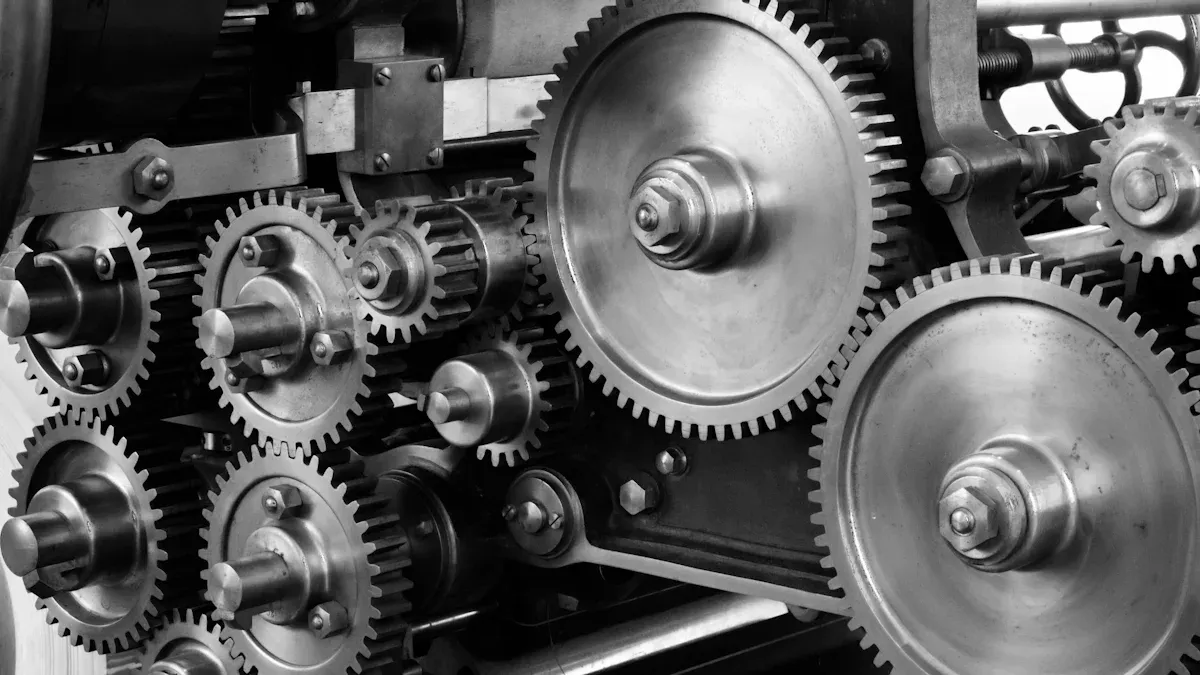
Power Flow
An excavator uses a complex system to transfer power from the engine to every moving part. The engine creates mechanical energy. Hydraulic pumps convert this energy into hydraulic power. This power moves through valves and pipelines to reach the actuators. The hydraulic motor and cylinders use this energy to create movement. The final drive receives power from the hydraulic motor. It reduces speed and increases torque. This process helps the excavator move heavy loads with ease. The drive shafts connect the hydraulic motor to the final drive, ensuring smooth power delivery. Bearings and seals protect these moving parts and keep the system efficient. The undercarriage and track assembly use the final drive’s torque to move the excavator across rough ground. Each part must work together to maintain stability and high performance. Sensors monitor power flow and energy use, helping operators adjust for better efficiency. The system must balance power, torque, and energy to keep the excavator stable and reliable.
Coordination of Parts
Excavator transmission parts must coordinate to achieve top performance and stability. Engineers use several methods to analyze and improve this coordination:
Hydraulic transmission and energy conversion: Pumps and valves turn engine energy into hydraulic power for actuators.
Computational Fluid Dynamics (CFD): Simulates hydraulic flow to reduce energy loss and improve power delivery.
Mechanical structure design: Finite Element Analysis (FEA) checks that connecting rods and joints can handle stress and keep stability.
Electronic control and feedback: ECUs and sensors track hydraulic pressure, temperature, and actuator position. This real-time data supports precise control and predictive maintenance.
Computer-Aided Design (CAD): Models stress on parts to ensure safety and stability.
Sensor integration: GPS, acceleration, and tilt sensors work with smart algorithms to adjust operational parameters for better performance.
Multi-dimensional simulation: Combines hydraulic, mechanical, and electronic analysis to show how all parts coordinate in real excavator operations.
Operators rely on this coordination to keep the excavator stable, deliver the right amount of power, and maintain high performance. The final drive, torque converter, and undercarriage must all respond quickly to changes in load and terrain. This teamwork ensures the excavator can handle tough jobs while protecting every part from damage.
Maintenance and Replacement Tips
Routine Maintenance
Routine excavator maintenance keeps all parts working smoothly and prevents sudden failures. Operators should follow a schedule that includes daily, weekly, and monthly tasks. Daily checks involve inspecting fluid levels, looking for leaks, and making sure all safety devices work. Every 50 to 100 hours, lubricate joints and bearings to reduce friction and wear. Change engine oil and filters every 250 to 300 hours. Clean or replace air filters every 100 hours to keep the engine running efficiently. Inspect the cooling system and radiator every six months to prevent overheating. Fuel system checks and cleaning the injection system every 300 hours help maintain power and reduce engine wear. Using professional diagnostic tools allows real-time monitoring of engine and transmission health. Preventive maintenance, such as scheduled inspections and proactive replacement of worn parts, increases reliability and extends the life of the excavator.
Tip: Employee training in excavator maintenance helps operators spot problems early and perform tasks correctly, reducing downtime and repair costs.
Signs of Wear
Early detection of wear in excavator transmission parts prevents major breakdowns. Operators should watch for abnormal vibrations, which often signal wear in drive shafts or final drive components. Temperature sensors can reveal overheating in the transmission or final drive, showing friction or lubrication problems. Oil quality sensors detect contamination or metal particles, which indicate internal wear in moving parts. Unusual noises, leaks, or changes in machine performance also suggest issues with the final drive or other critical parts. Telematics systems and IoT sensors provide real-time data, helping maintenance teams act before small problems become big failures. Regular inspections of the undercarriage, bearings, and seals help catch wear early and keep the excavator running safely.
When to Replace
Knowing when to replace excavator parts ensures safe and efficient operation. The engine usually lasts 2,500 to 5,000 hours with good maintenance. Hydraulic pumps and cylinders have a design life of 3,000 to 5,000 hours. Inspect tracks and drive wheels every 200 to 300 hours, replacing worn pads or plates as needed. Bucket edges and teeth should be checked after each season and replaced if worn. The table below shows typical replacement intervals for key parts:
Part Type | Replacement Criteria | Typical Interval (Hours) |
|---|---|---|
Filters (air, fuel, hydraulic) | Replace by condition or schedule | 250 – 500 |
Lubricated joints and bearings | Grease regularly | 50 – 100 |
Wear parts (bucket teeth, edges) | Inspect and replace as needed | Varies by use |
Fluids (oil, hydraulic, coolant) | Change based on hours and environment | Oil: 250-500; Hydraulic: 1000-2000 |
Undercarriage, drive, final | Inspect and replace worn parts | 250 – 1000 |
Structural parts (boom, stick) | Inspect for damage, replace if needed | By inspection |
Remote monitoring and digital maintenance systems help predict part life and schedule replacements. Following manufacturer guidelines and using high-quality parts for the final drive and other systems keeps the excavator safe and productive.
The main transmission parts include the final drive, final gears, final bearings, final seals, final clutches, final shafts, final torque converters, final undercarriage, final track assembly, and final hydraulic motor. Each final part supports drive power and drive movement. Good drive maintenance improves drive performance. Strong drive performance depends on final drive care. Operators should check final drive parts often. Regular drive inspections help final drive performance. Use the tips for better drive performance. Seek help from a professional for final drive repairs or final diagnostics.
Regular final drive care leads to better performance and longer final drive life.
FAQ
What is the main function of the final drive in an excavator?
The final drive transfers power from the hydraulic motor to the tracks. This part reduces speed and increases torque. The final drive helps the excavator move heavy loads and keeps the machine stable on rough ground.
How often should operators inspect the final parts of an excavator?
Operators should check the final parts every day before use. They need to look for leaks, cracks, or unusual noises. Regular inspection of the final drive and other final components helps prevent breakdowns and keeps the excavator safe.
What signs show that the final drive needs replacement?
Unusual noises, vibration, or oil leaks often mean the final drive has problems. If the final parts show wear or the excavator loses power, replacement may be needed. Early action prevents more damage to the final system.
Why is using OEM parts important for the final drive?
OEM parts fit the final drive perfectly. They last longer and protect the final system from early failure. Using the right final parts keeps the excavator running smoothly and reduces repair costs.
Can a damaged final drive affect other excavator parts?
A damaged final drive can cause extra stress on the final gears, bearings, and seals. This stress may lead to more wear on the final system. Quick repairs help protect all final components and keep the excavator working well.
